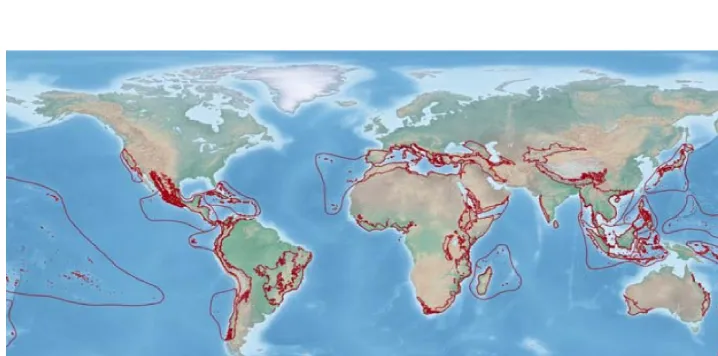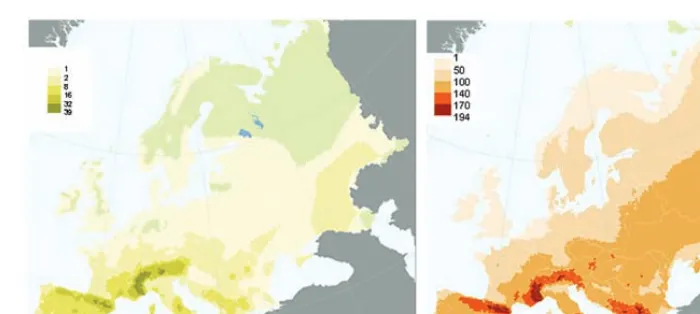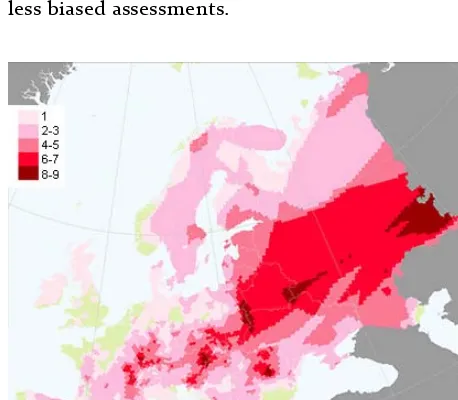Biodiversity and comparative phylogeography of western Mediterranean butterflies
Texto completo
(2) .
(3) . . Institut de Biologia Evolutiva (CSIC-‐UPF) . Universitat Autònoma de Barcelona . Biodiversity and comparative phylogeography of western Mediterranean butterflies ___________________________________________________________ Biodiversitat i filogeografia comparada de les papallones de l’oest de la Mediterrània ___________________________________________________________ Biodiversidad y filogeografía comparada de las mariposas del oeste del Mediterráneo – DOCTORAL THESIS – Raluca Vodă Bellaterra, 2015 Facultat de Biociències -‐ Departament de Genètica i Microbiologia Memòria presentada per optar al grau de doctor per la Universitat Autònoma de Barcelona Programa de Doctorat en Genètica Vist-‐i-‐plau dels directors/tutor de la tesi Director Director Dr. Roger Vila Ujaldón Dr. Leonardo Dapporto Institut de Biologia Evolutiva Institut de Biologia Evolutiva (CSIC-‐UPF) (CSIC-‐UPF) Animal Biodiversity and Evolution Animal Biodiversity and Evolution Program Program Tutor Author Prof. Alfredo Ruíz Panadero Raluca Vodă Universitat Autònoma de Barcelona, Institut de Biologia Evolutiva Departament de Genètica i (CSIC-‐UPF) Microbiologia Animal Biodiversity and Evolution Program .
(4)
(5) . . BIODIVERSITY AND COMPARATIVE PHYLOGEOGRAPHY OF WESTERN MEDITERRANEAN BUTTERFLIES . ~Doctoral Thesis~ . . . Raluca Vodă .
(6)
(7) Table of contents 1. Introduction …………………………………………………………………………………………….. 11 1.1 The study system: butterflies of the western Mediterranean ……....…….. 13 The study region ………………………………………………………………………………….…….. 13 Butterflies as a model system ……………………………………………………………………. 26 The butterflies of the western Mediterranean ..…………………………………………. 30 Conservation in the ‘Anthropocene’ epoch ……………………………………………….. 34 1.2 Biodiversity and Biogeography …………………………………………………………….. 39 Species assembly and community structure ……………………………………………… 39 Measures of faunal dissimilarity between communities …………………………... 49 DNA barcoding -‐ a tool for comparative phylogeography …………….………….. 51 Phylogeography: analysing distribution patterns of genetic lineages ………………………………………………………………………………………….……..…… 55 1.3 The new era of island biogeography …………..………………………………………… 65 2. Objectives …………………………………………………………………………….………………….. 73 3. Results ……………………………………………………………………………….…………………….. 75 Chapter I. Biogeography of western Mediterranean butterflies: combining turnover and nestedness components of faunal dissimilarity ……….………………….. 77 Chapter II. Cryptic matters: overlooked species generate most butterfly beta-‐ diversity ………………………………………………………………………………….………………………….. 91 Chapter III. Why do cryptic species tend not to co-‐occur? A case study on two cryptic pairs of butterflies …………………………………………………………………………………. 99 .
(8) Chapter IV. Comparing population patterns for genetic and morphological markers with uneven sample sizes. An example for the butterfly Maniola jurtina ………………………………………………..…. 119 Chapter V. What makes island communities unique? Understanding and protecting butterfly diversity at the interface between Africa and Europe ….…… 131 4. General discussion …………………………………...………………………….………………. 159 5. Conclusions ……………………………………………………………………………………......... 169 References ……………………………………………………………………………………………….… 175 .
(9) Acknowledgments . A PhD student needs a lot of help – or maybe that was just me. Anyway, there are so many people and so many favourable events that helped me have four amazing years that changed my life completely. First of all I would like to thank my wonderful family: my parents, who made me discover and love nature during our many ‘field trips’ together and who taught me the true values in life: be honest, work hard and be kind to people, and my sister and best friend, Ana, who always stood by me when life was tough and encouraged me through it all. Without you I would not be where I am today. I love you all so much! I also want to thank my extended family (you know who you are) for their unconditioned care and support. This thesis would not have been possible without the help of three very knowledgeable, generous, and patient people who helped me in my ‘quest’. I would like to thank the two greatest supervisors I could have ever wanted: Roger, you gave me freedom to work in my own pace and you trusted me that I could do anything I put my mind to. Thank you for being a friend and not a boss, and for teaching me so many things! I will never forget the amazing field trips together, some of them real tests of our physical limits. Leonardo, thank you so much for your guidance, friendship and for gradually turning me into an ‘islomaniac’. Our endless butterfly conversations were such an amazing source of knowledge and inspiration, even though we often got ‘lost in translation’… but definitely not while singing Bohemian Rhapsody. Vlad, there are so many things I want to thank you for … You always inspire me and not only you make me better but you make me want to be better. Your patience, kindness and love make everything that I do possible. I would like to thank Prof. László Rákosy who is the reason I started to love the beautiful insects I study, who gave me my first butterfly net and who encouraged and helped me in difficult times. I would also like to thank Prof. Tim Shreeve for giving me the opportunity to have a great experience and a rewarding stay at Oxford Brookes University. I am grateful to Prof. Paul Hebert and to the Biodiversity Institute of Ontario, Canada for a very fruitful collaboration. Sylvain, thank you for the field trips and the thousands kilometres we travelled to reach all the wonderful places you know or that we discovered together, for your friendship, for sharing your entomological experience but also a beer at the end of a collecting day. .
(10) I would also like to thank Sandra, Sabina, Diana, Alícia, Santi, Carme for welcoming me with open arms when I first moved here, and for always helping and caring for me. A big thank you to the administration at IBE: Anna, Rita, Blanca, Emiliano, and Vicente, for their patience and for helping me not to get lost in the bureaucratic world. A big thank you to all my friends, old and new … To my colleagues and friends in the Butterfly Diversity and Evolution Lab: Gerard, Marga, Juan, Sergio, Josep, Claudia, Martha, Lucas, and the newest member, Camille. I want to thank you for all the help you gave me during this time, for your friendship, support and for all the good times we shared. Thanks also to ‘the other group’ in the lab: Lain, Lidia, Anna, Miriam, for such a nice co-‐existence. Life as a PhD student would have been so much boring without you: Marina, for being such a great friend, Joan, Elena, DAVID, David, Marc, Cristina, Nuria, Claudia, Anna P., Ana R., Javi, Santi, Carlos, Helena -‐ for all the home dinners, outings and for so many great times we had together. To my dear friends, Andrea and Clara with whom I experienced ‘life in Barcelona’. I care for you both so much! To the Italian ‘butterfly family’: Stefano, Luca, Ale, Mattia, Leonardo and Jacopo. I cannot wait for the next butterfly week! I also want to thank my home friends, and in particular Andreea (for endless memories), Gabi, Silvia, Natalia for their wonderful friendship and to my lovely weird cat Ariel whom I miss a lot … I would also like to acknowledge the financial support of a four-‐year predoctoral scholarship from the Spanish Ministerio de Economía y Competitividad (AP-‐ 2010-‐5409). Many thanks to all the colleagues and institutions that supported my research in numerous ways, including by providing precious samples. And finally, I am grateful to the beautiful creatures I study for saving my life – and this is not an overstatement! .
(11) Abbreviations bp – base pairs . COI -‐ cytochrome c oxidase subunit I mya – million years ago ENM – Ecological Niche Modelling ETIB – Equilibrium Theory of Island Biogeography LGM – Last Glacial Maximum mm – millimetres mtDNA – mitochondrial DNA MSC – Messinian Salinity Crisis nuDNA – nuclear DNA .
(12)
(13) 1. Introduction .
(14)
(15) The study system: butterflies of the western Mediterranean . . . 1.1 The study system: butterflies of the western Mediterranean . The study region “What is the Mediterranean? One thousand things at a time. Not just one landscape but innumerable landscapes. Not just one sea, but a succession of seas. Not just one civilization but many civilizations packed on top of one another. The Mediterranean is a very old crossroads. Since millennia, everything converged on it.” (Braudel 1985) The Romans called the Mediterranean sea ‘mare nostrum’, meaning ‘our sea’, but also ‘mediterraneus’, Latin for ‘the sea in the middle of the Earth’, while at the other end of the sea the Turkish referred to it as ‘Akdeniz’, ‘the white sea’ (Öztürk 2011), as for them the colour white represents ‘the west’ (DeLong & Martinson 2012). More recently, Blondel et al. (2010) proposed that a suitable name would be the ‘sea-‐among-‐the-‐mountains’, because of the almost complete ring of mountains that encircles the Mediterranean basin. But the Mediterranean means much more than a sea – it is a landscape, a climate, a biome, an ancient culture, a lifestyle (King et al. 1997); it is “one of the richest and most complex regions on Earth” (Blondel et al. 2010). Geology The formation of the Mediterranean basin was a long process that started around 250 mya during the Mesozoic era, and it is the result of a series of powerful and complex movements of tectonic plates (Rosenbaum et al. 2002a, Blondel et al. 2010). At the beginning of the Jurassic period the ancient supercontinent Pangaea started to split into two smaller continents, Gondwana to the south and Laurasia to the north. The two landmasses continued to fragment throughout the Mesozoic, giving rise to the continents and oceans we know today. North America and Europe started to move apart from Africa around 165 mya as a . 13 .
(16) The study system: butterflies of the western Mediterranean . . consequence of the seafloor spreading that created the Atlantic Ocean (Blondel 2010). The opening of the Atlantic and the northeastern movement of the Afro-‐ Arabian plate towards a fixed Eurasia led to the formation of a large ocean basin in between the two plates, extending from the western Mediterranean to the eastern Himalayas (Coward & Dietrich 1989). This ancient ocean called Tethys was the predecessor of the present Mediterranean, Caspian, Aral and Black seas (Suess 1893, Faccenna et al. 2001, Rosenbaum et al. 2002a). Following its northeastern movement, Africa first collided with Eurasia during the Oligocene, generating the uplifting of several mountain chains, including the Alps and the Pyrenees, as well as the consumption of the former Tethys Ocean (Hsü 1971, Coward & Dietrich 1989, Jolivet & Faccenna 2000, Faccenna et al. 2001, Blondel 2010). The Alpine orogenesis occurred in two distinct episodes, for the Eastern and Western Alps throughout the Cretaceous and for the Central Alps throughout the Tertiary (Pfiffner 1992). During the orogenesis of the Alps several other tectonic processes played a major role in the formation of the western Mediterranean basin. Large-‐scale horizontal extensions associated with subduction rollback (the backward migration of the subducting plate), back-‐arc extension (the extension of an arc crust as a result of the sinking of the subducting slab) and accretion events were the driving mechanisms in the tectonic evolution of this region (Rehault et al. 1985, Malinverno & Ryan 1986, Royden 1993, Lonergan & White 1997, Jolivet & Faccenna 2000, Rosenbaum et al. 2002a, Rosenbaum et al. 2002b, van Hinsbergen et al. 2014). Although reconstructions of the western Mediterranean region are widely similar (van Hinsbergen et al. 2014), there are still debates regarding the initiation age of the subduction between Africa and Iberia (Faccenna et al. 2001, Rosenbaum et al. 2002a, Handy et al. 2010) and about the lateral extent of the western Mediterranean subduction zone (Lonergan and White 1997, Rosenbaum et al. 2002a, Rosenbaum & Lister 2004, Schettino & Turco, 2006). The convergent movement of the African-‐Arabian plate towards Eurasia started to slow down around 30 mya (Jolivet & Faccenna 2000, McQuarrie & Hinsbergen 2013). In the absence of a sufficient convergence to support subduction rollback, the overriding plate underwent extension from west to east, leading to the opening of several basins in the Mediterranean (Rosenbaum et al. 2002b). Moreover, these large-‐scale extensions were responsible for the breakup, drift and rotation of different continental blocks that were formerly connected to 14 . .
(17) The study system: butterflies of the western Mediterranean mainland (Rosenbaum et al. 2002a). This is the case of Corsica, Sardinia, the Balearic Islands, the Kabylies, Calabria and the internal part of the Rif-‐Betic Cordillera. During the Oligocene these fragments were attached to Europe, between northern Spain and southern France, where today the Gulf of Lion is located (Ricou et al. 1986, Lonergan & White 1997, Rosenbaum et al. 2002a) (fig. 1). Corsica, Sardinia and Calabria started to rotate counterclockwise during the opening of the Ligurian and Tyrrhenian seas (fig. 1 b, c) and collided with the Apennines around 18 mya (fig. 1 d, e, f). The Apennines incorporated in the subduction area and stopped further eastward subduction rollback (Rosenbaum et al. 2002a). The Balearic Islands started to rotate clockwise when the Valencia Trough opened (Pares et al. 1992) (fig. 1 b). Around 21 mya the Kabylies separated from the Balearics and due to southward rollback of the subduction zone they started to move towards the south (fig. X 1 c, d), until they collided and accreted to the territory of today’s Algeria (Tricart et al. 1994) (fig. 1 e, f, g). The reconstruction of the Rif-‐Betic position is still debated but according to the model proposed by Lonergan & White (1997) and Rosenbaum et al. (2002a), the origin of this block is the Gulf of Lion (fig. 1 a). After separation from mainland the Rif-‐Betic fragments started to drift southwestwards until they reached the passive margin of north Africa (fig. 1 b, c, d) and continued to move towards the Gibraltar strait (Rosenbaum et al. 2002a). Around 10 mya they accreted to Iberia and Africa, respectively, followed by the cessation of back-‐arc extension and rollback subduction in this area (Lonergan & White 1997, Rosenbaum et al. 2002a) (fig. 1 e, f, g, h). All these tectonic processes and others, like earthquakes and volcanic activity, had an immense influence not only on the geology of the Mediterranean basin, but also on the distribution of animals and plants and in particular they formed the basis for the observed patterns of endemicity in this region (Blondel et al. 2010). The Messinian Salinity Crisis – a trilogy of the Mediterranean An event that is often advocated as one of the main drivers for the emergence of a distinctive fauna and flora in the Mediterranean is the Messinian Salinity Crisis (MSC). This short but extreme episode occurred in the late Miocene, following the progressive closure of the Gibraltar strait, the only marine gateway that connected the Mediterranean sea with the Atlantic ocean (Hsü et al. 1973, . 15 .
(18) . The study system: butterflies of the western Mediterranean . Figure 1 Illustration of the different key events in the formation and evolution of the western Mediterranean basin, between 30 and 2 mya. [Extracted from Rosenbaum et al. 2002a] . 16 . .
(19) The study system: butterflies of the western Mediterranean Duggen et al. 2003, Ryan 2011). Although the causes of the closure are still not fully understood, the isolation was enough for the Mediterranean sea to dry up almost completely (Hsü et al. 1973, Krijgsman et al. 1999, Duggen et al. 2003, Blondel et al. 2010). This event started about 5.9 mya and ended some 600 000 years later, around 5.3 mya, although the chronology is still debated (Krijgsman et al. 1999, Roveri & Manzi 2006, Rouchy & Caruso 2006, Blondel et al. 2010, Cosentino 2013, Manzi et al. 2013). Because the Mediterranean is almost 90% fed with water from the Atlantic Ocean, an obstruction of the narrow strait of Gibraltar would determine a decrease of the sea level with more than one meter each year (Blondel et al. 2010). It probably took less than 1000 years for the Mediterranean to have a major sea-‐ level drop of more than 1500 m (Ryan & Cita 1978, Suc 1984). This dry-‐up was followed by an accumulation of very large and thick seabed salt deposits (Hsü et al. 1973, Lofi et al. 2005, Gaullier et al. 2010) and by massive erosions of the basin’s margins and the formation of deep subaerial canyons. Several submerged gorges still exist in places where rivers such as the Nile or the Rhône were feeding the Mediterranean (Blondel et al. 2010, Lofi et al. 2011). For instance, a gorge 900 m below sea level was found near Marseille, where the Rhône flowed into the Mediterranean (Blondel et al. 2010). The MSC had three main stages, characterized by different paleoenvironmental conditions (Roveri et al. 2014). First, evaporites precipitated in shallow basins then passed to the deepest depocentres during the second stage, and finally the Mediterranean transformed into a brackish water lake in the last “Lago di Mare” phase, which was characterized by large-‐scale environmental fluctuations (Roveri et al. 2014). At the beginning of the Pliocene a series of tectonic events broke the land bridge between Africa and Europe and the Mediterranean basin started to refill rapidly (Blanc 2002, Loget & Van Den Driessche 2006). It is believed that when the waters of the Atlantic Ocean started to submerge in the Mediterranean, huge cascades of up to 4000 m high were formed, although evidence for these waterfalls was not yet found (Blondel et al. 2010). The MSC was defined as an ecological crisis driven by a combination of glacio-‐ eustatic and tectonic events that had a tremendous impact on the marine and terrestrial faunas and dramatic consequences for the subsequent geological history of the Mediterranean region and for the salinity of all the oceans (Roveri . 17 .
(20) . The study system: butterflies of the western Mediterranean . et al. 2006, Manzi et al. 2013, Roveri et al. 2014). Most probably, many marine organisms could not survive in such extreme conditions of dryness and salinity, while others could have persisted in deep areas or near large rivers (Por 2009, Calvo 2015). During the MSC many regions that were separated by the sea for million years got into contact, like Corsica with Sardinia, Morocco with Spain, Tunisia with Sicily, or the Balearic Islands with Spain (Rögl & Steininger 1983, De Jong 1998), but probably also the reverse occurred and several areas that acquired favourable conditions for terrestrial life remained isolated between the salty beds. Several studies suggested that this short period of connection between lands could be an explanation for the vicariance patterns found in many species that are now separated by sea, including butterflies. There is vicariance between lineages occurring in Morocco and Iberia, like in the case of Zerynthia rumina (Nazari & Sperling 2007), several members of the genus Elphinstonia (Back et al. 2005), or different lineages and species from the genus Melanargia (Nazari et al. 2010). Another case that could be explained by the MSC is the one of Coenonympha corinna, an endemic butterfly that occurs on several Mediterranean islands. It seems that the ancestor of this butterfly colonized Sardinia, Corsica and the surrounding islands from the Maghreb during the MSC and remained isolated when the waters returned (Kodandaramaiah & Wahlberg 2009). MSC was probably the most spectacular event during the Cenozoic era (Blondel et al. 2010) and is a logical hypothesis for the origin of the several endemic butterflies in the Mediterranean islands. Glaciations Climate has a major impact on driving global biogeographic patterns and fast changes in species distributions after recent climate change have been documented for various taxa (Parmesan 1999, Devictor et al. 2012 for individual butterflies . species . and . communities). . Fossil . evidence . and . current . phylogeographic patterns show that the Pleistocene ice ages, in particular, had a tremendous impact on the past distribution of species and their effects are still visible in the current distribution of species and genetic lineages (Hewitt 1993, 1996, 1999, 2000, Taberlet et al. 1998). It has been postulated that changes in the Earth’s orbit, coupled with changes in atmosphere composition, have led to Quaternary climatic oscillations (Hays et al. 1976) in cycles of 100 000, 41 000 and 19 -‐ 23 000 years (Taberlet & Cheddadi 2002, Hewitt 2000). Thus, over the past 2 18 . .
(21) The study system: butterflies of the western Mediterranean my glacial and interglacial periods alternated, with cold intervals being much longer than warm ones (Blondel et al. 2010) (fig. 2). There were about ten major ice ages with warm intervals in the last one my (Hewitt 2011). In fact Davis (1976) asserted that the Quaternary was “a cold epoch interrupted periodically by catastrophic warmer events – the brief interglacials with climate similar to that of today”. . Figure 2 Climatic oscillations (temperature change and ice volume) in the past 450 ooo years. [Modified from the graph produced by Robert A. Rohde, University of California, Berkeley] . In the Mediterranean, although the modern climate was established around 2.8 mya, the Pleistocene climatic fluctuations shifted repeatedly and severely affected species, which had to move back and forth in search of suitable habitats (Blondel et al. 2010). The toughest Pleistocene conditions for species survival in northern and central Europe were during the Last Glacial Maximum (LGM), when ice covered the European continent as low as Warsaw (Poland) and Norwich (UK) (Hewitt 2011). This ‘compressed’ plant and animal biota to the southern regions, in particular in the Iberian, Italian and Balkan Peninsulas, which played a fundamental role for the survival, diversification and subsequent recolonization of the north (Hewitt 2000, Schmitt 2007). For a long time the Maghreb was not recognized among the main refugia, but recent studies revised its high level of endemicity (Husemann et al. 2014) and presented evidence for refugial-‐expansion phenomena between north Africa and Europe, at least for butterflies (Habel et al. 2005, 2008, 2009). . 19 .
(22) The study system: butterflies of the western Mediterranean . . Less drastic climatic changes occurred in the dozen Mediterranean islands, which also represented important places for species survival in the Mediterranean (Masini et al. 2008, Médail & Diadema 2009, Dapporto 2010). During interglacial periods, the populations that were isolated (and presumably diverged in allopatry) in different refugia, expanded their distribution towards the north (Taberlet et al. 1998, Hewitt, 1999). Advances of molecular techniques and good fossil records helped researchers establish the limits of refugial ranges and also to infer possible colonisation routes. Although each species has its own colonisation particularities, Hewitt (2000) described three main paradigms of glacial contraction and interglacial expansion of European biotas (fig. 3). Each of the main refugial areas had multiple minor sub-‐refugia and contributed differently to the recolonization by various species (Provan & Bennett 2008, Hewitt 2011). Lineages from the Balkans are the most frequent post-‐glacial colonizers of central Europe, followed by Iberian and with much fewer numbers the Italian ones (Hewitt 2000, 2004). The later two were probably less frequent because the Alps and Pyrenees mountains impeded their dispersal. However, recent evidence indicates that Hewitt's contraction/expansion models might be too simplistic to depict the more complex biogeographic histories. For instance, genetic data show that fossil individuals of Ursus arctos (the model species for the ‘Bear Paradigm’, fig. 3) from Iberia belong to the eastern lineage and specimens collected in the Carpathian mountains belong to the western one (Valdiosera et al. 2007). Thus, the phylogeography of this species, and several others, has been shaped by complex and multiple invasions and retractions, sometimes impeding allopatric speciation. Direct assessments of past movements of invertebrates are even more complicated, largely because for most taxa there are no fossil data and past movements are usually reconstructed indirectly, by modelling present distributions and genetic variability. For butterflies, several studies that combined these approaches reconstructed the evolutionary, immigration and extinction events of certain taxa and a fourth possible paradigm was proposed – the ‘Buttefly Paradigm’ (Habel et al. 2005). This new colonization route was based on the pattern found in Melanargia galathea/lachesis/lucasi complex and it postulated that Iberian lineages were not able to expand more than southern France, therefore central and northern Europe was colonized by. 20 . .
(23) The study system: butterflies of the western Mediterranean . Figure 3 The three main postglacial colonization routes, based on DNA differences for the grasshopper (Chorthippus parallelus), the hedgehog (Erinaceus europeus/concolor) and bear (Ursus arctos). [Extracted from Hewitt 2000] . Italian and Balkan lineages. This pattern was also retrieved in other two European butterfly species, Polyommatus bellargus and P. coridon/hispana (Schmitt & Seitz 2001, Schmitt et al. 2005a). However, the inferred colonization events of several other species did not match the ‘Butterfly Paradigm’. In the case of Polyommatus icarus and several species in the Satyrinae subfamily it has been shown that different genetic lineages repeatedly invaded and presumably replaced the original ones throughout their distribution range (Dincă et al. 2011a, Dapporto & Bruschini 2011, Dapporto et al. 2012). These studies also highlighted that many times the secondary invasions were stopped at sea straits, explaining a larger concentration of relict species on islands (Masini et al. 2008 for fossil evidence, Dapporto et al. 2011, 2012 for butterflies). Recent phylogeographic studies are adding new evidence to the complex recolonization history and show that unknown glacial refugia, called ‘cryptic refugia’, existed outside the Mediterranean basin (Provan & Bennett 2008). The great amount of lineages that expanded towards the north encountered along the way other different lineages that survived in these smaller refugia and produced mixed biotas, often with the formation of hybrid zones (Hewitt 1998, 2004). A recurrent finding is that these contact zones are in most cases very narrow, suggesting that dispersal of individuals belonging to one lineage in the area occupied by the other lineage is hampered by several possible factors, such as density dependent phenomena, competition, reproductive interference or adaptation to local environmental settings (Waters et al. 2011). . 21 .
(24) The study system: butterflies of the western Mediterranean . . Besides climatic oscillations, there was another phenomenon associated with Quaternary glaciations. During glacial periods the sea water level lowered with a maximum of about 100 m. In these conditions many present-‐day islands were connected to continents, others considerably extended their surface and some islands that today are below sea level emerged from the waters (Whittaker & Fernández-‐Palacios 2007). The land connections were a perfect route for biotic exchange between areas that are currently no longer in contact. In the Mediterranean, the circum-‐Sicilian islands and most of the islands in the Tuscan Archipelago were connected with the Italian Peninsula during the Pleistocene sea regression (Dapporto & Cini 2007, Fattorini 2009, 2011). Research done on various groups of organisms occurring on these islands (butterflies, chrysids, tenebrionids, reptiles and molluscs) provided evidence that some species colonized the islands from the Italian mainland, during the temporary land connection. Some of them probably underwent subsequent extinctions after the LGM, as a result of the decrease in area and habitat loss, but others persisted and evolved into endemic species (Fattorini 2009, 2011). The western Mediterranean today Geologic and climatic events concurred into shaping the western Mediterranean basin (fig. 4). Today this region is formed by a mosaic of landscapes, from mountains as high as 4000 m, fertile hilly areas, semi-‐arid steppes, coastal lands, dozens of superb islands of different origin, to extended deserts that are bordering the south (Box 1). All these environments are tremendously heterogenous and have marked local variations in climate, topography or soil types. The western Mediterranean is also considered as a ‘tension zone’ (Raven 1964), situated in-‐between two deserts: a hot one to the south (Sahara) and a cold one to the north (northern Scandinavia). All these, combined with its geographical position at the interface between two continents – Africa and Europe – produced a very distinctive flora and fauna (Blondel et al. 2010). Before the Quaternary the Mediterranean was largely covered by deciduous and partly evergreen trees, some which persisted until the present, accompanied by several tropical and subtropical arboreal taxa that went extinct probably due to glaciations and the MSC (Sadori et al. 2013). During glacial periods the most widespread vegetation types were the steppe and grasslands, while the interglacials were characterised by deciduous or evergreen forests (Sadori et al. 22 . .
(25) The study system: butterflies of the western Mediterranean . Figure 4 An approximate delimitation (pink shade) of the western Mediterranean basin, based on the delineation made by Blondel et al. (2010). The main mountain chains are highlighted. . 2013). The present day Mediterranean vegetation has been shaped by climatic oscillations since the second half of the present interglacial and by human impact. Today, the most characteristic and widespread vegetation type is the maquis or matorral, with species from the genera Quercus, Erica, Juniperus, Myrtus, Olea, Phillyrea, and Pistacia (Tomaselli 1977). Other characteristic Mediterranean species belonging to the genera Arbutus, Calluna, Ceratonia, Chamaerops, and Larus are tropical relicts from forests that were dominant two million years ago (Moreira et al. 2012). Shrubland with Artemisia, Lavandula, Rosmarinus, Salvia and Thymus are also a common occurrence in the semi-‐arid, lowland, and coastal regions, forming the typical garrigue or phrygana (Moreira et al. 2012). The Mediterranean has been a meeting ground where taxa of various origins interacted, hybridized, or speciated (Blondel et al. 2010). The diversity of plants and animals is therefore composed by a mixture of species that either evolved in situ or dispersed from other regions recently or in the distant past (Blondel et al. 2010). The Mediterranean has a particularly high diversity of flowering plants – more than 25 000 are native to this region (Vogiatzakis et al. 2006, Médail 2008) . 23 .
(26) . The study system: butterflies of the western Mediterranean . and more than half of them are endemic (Cuttelod et al. 2008). This, as well as the rich diversity and endemism of other groups of organisms, explain that the Mediterranean is considered one of the 35 biodiversity hotspots in the world (Fig. 5) . (Myers . et . al. . 1999, . Mittlemeier . et . al. . 2004, . http://www.conservation.org/How/Pages/Hotspots.aspx). The climate of the Mediterranean is dominated by cool and wet winters and hot, dry summers, while rainfall ranges from as little as 100 mm to as much as 4000 mm in some areas (Blondel et al. 2010). Snowfalls are rare in the Mediterranean, except on the mountains, but periods of frost can be common and cause high mortality in plants and animals, especially if they occur after a warmer period. The Mediterranean is governed by a wide range of winds that have major impacts on living organisms. In winter, the most preponderant winds are the mistral, blowing from the northwest, the tramontane, blowing from the north, bora from north-‐north-‐east and the gregale, a north-‐eastern wind that is especially dreaded in Malta island for its powerful force. During warmer climate the sirocco takes over from Africa towards the Mediterranean sea, although in north . Figure 5 The 35 biodiversity hotspots around the world defined by Conservation International. An area is considered as hotspot if it has at least 1500 vascular plants (> 0.5 percent of the world's total) as endemics and 30% or less of its original natural vegetation. [Based on the data provided by the Critical Ecosystem Partnership Fund at http://www.cepf.net/] . . 24 . .
Figure
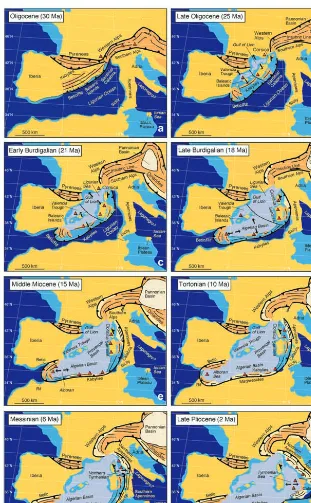
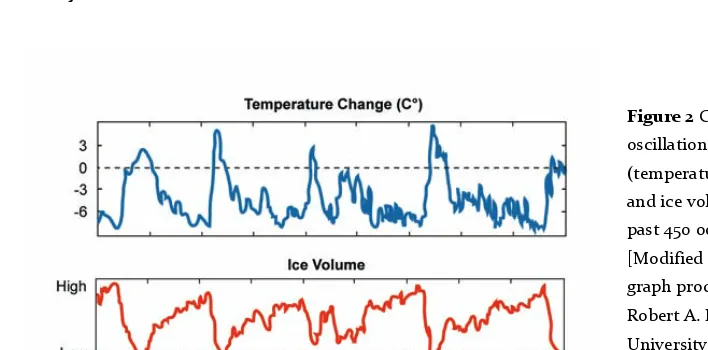
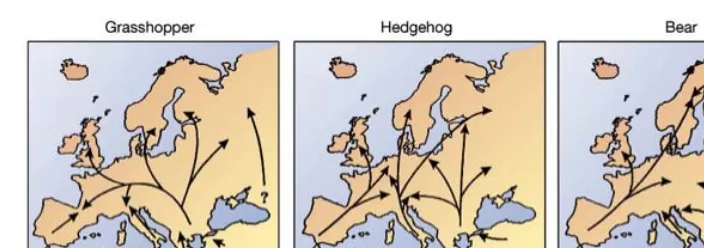
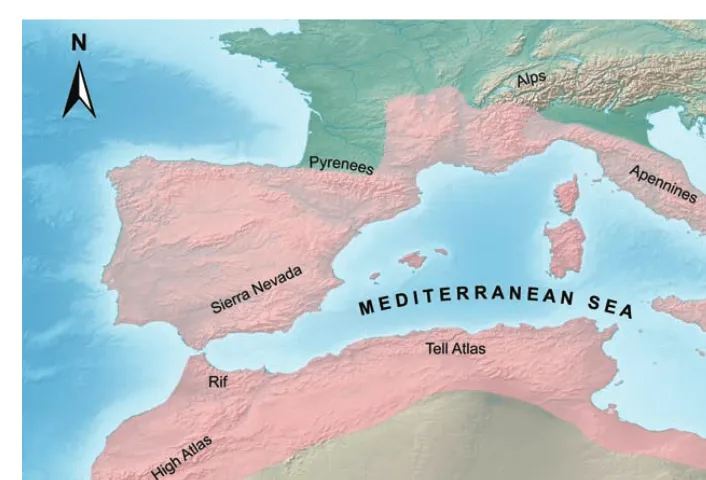
Documento similar
In the preparation of this report, the Venice Commission has relied on the comments of its rapporteurs; its recently adopted Report on Respect for Democracy, Human Rights and the Rule
In the previous sections we have shown how astronomical alignments and solar hierophanies – with a common interest in the solstices − were substantiated in the
While Russian nostalgia for the late-socialism of the Brezhnev era began only after the clear-cut rupture of 1991, nostalgia for the 1970s seems to have emerged in Algeria
Díaz Soto has raised the point about banning religious garb in the ―public space.‖ He states, ―for example, in most Spanish public Universities, there is a Catholic chapel
After the Spanish withdrawal from the territory in 1975, Morocco waged a brutal military campaign against the Polisario, and large numbers of people fled to refugee camps, where
If the concept of the first digital divide was particularly linked to access to Internet, and the second digital divide to the operational capacity of the ICT‟s, the
In the “big picture” perspective of the recent years that we have described in Brazil, Spain, Portugal and Puerto Rico there are some similarities and important differences,
1. S., III, 52, 1-3: Examinadas estas cosas por nosotros, sería apropiado a los lugares antes citados tratar lo contado en la historia sobre las Amazonas que había antiguamente
